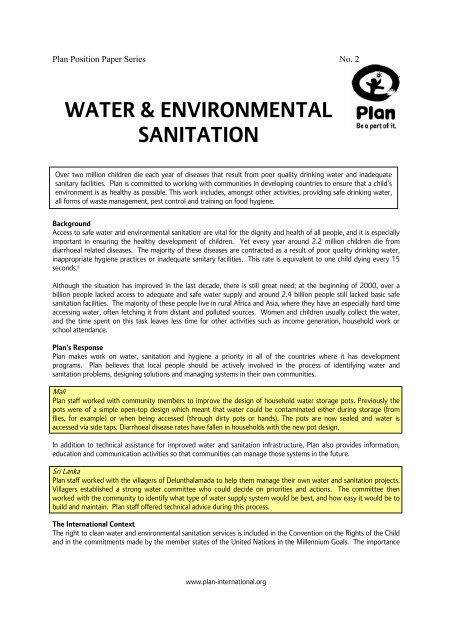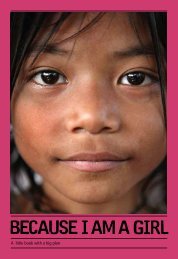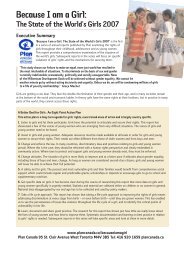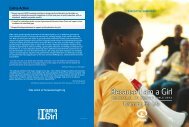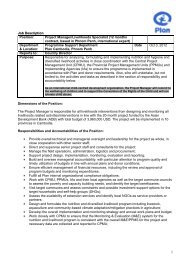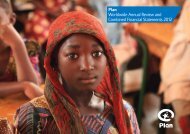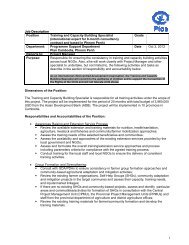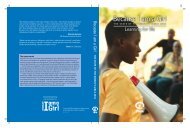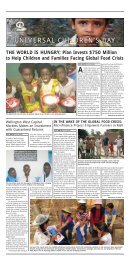WATER & ENVIRONMENTAL SANITATION - Plan Canada
WATER & ENVIRONMENTAL SANITATION - Plan Canada
WATER & ENVIRONMENTAL SANITATION - Plan Canada
Create successful ePaper yourself
Turn your PDF publications into a flip-book with our unique Google optimized e-Paper software.
<strong>Plan</strong> Position Paper Series No. 2<br />
<strong>WATER</strong> & <strong>ENVIRONMENTAL</strong><br />
<strong>SANITATION</strong><br />
Over two million children die each year of diseases that result from poor quality drinking water and inadequate<br />
sanitary facilities. <strong>Plan</strong> is committed to working with communities in developing countries to ensure that a child’s<br />
environment is as healthy as possible. This work includes, amongst other activities, providing safe drinking water,<br />
all forms of waste management, pest control and training on food hygiene.<br />
Background<br />
Access to safe water and environmental sanitation i are vital for the dignity and health of all people, and it is especially<br />
important in ensuring the healthy development of children. Yet every year around 2.2 million children die from<br />
diarrhoeal related diseases. The majority of these diseases are contracted as a result of poor quality drinking water,<br />
inappropriate hygiene practices or inadequate sanitary facilities. This rate is equivalent to one child dying every 15<br />
seconds. ii<br />
Although the situation has improved in the last decade, there is still great need; at the beginning of 2000, over a<br />
billion people lacked access to adequate and safe water supply and around 2.4 billion people still lacked basic safe<br />
sanitation facilities. The majority of these people live in rural Africa and Asia, where they have an especially hard time<br />
accessing water, often fetching it from distant and polluted sources. Women and children usually collect the water,<br />
and the time spent on this task leaves less time for other activities such as income generation, household work or<br />
school attendance.<br />
<strong>Plan</strong>’s Response<br />
<strong>Plan</strong> makes work on water, sanitation and hygiene a priority in all of the countries where it has development<br />
programs. <strong>Plan</strong> believes that local people should be actively involved in the process of identifying water and<br />
sanitation problems, designing solutions and managing systems in their own communities.<br />
Mali<br />
<strong>Plan</strong> staff worked with community members to improve the design of household water storage pots. Previously the<br />
pots were of a simple open-top design which meant that water could be contaminated either during storage (from<br />
flies, for example) or when being accessed (through dirty pots or hands). The pots are now sealed and water is<br />
accessed via side taps. Diarrhoeal disease rates have fallen in households with the new pot design.<br />
In addition to technical assistance for improved water and sanitation infrastructure, <strong>Plan</strong> also provides information,<br />
education and communication activities so that communities can manage those systems in the future.<br />
Sri . Lanka<br />
<strong>Plan</strong> staff worked with the villagers of Delunthalamada to help them manage their own water and sanitation projects.<br />
Villagers established a strong water committee who could decide on priorities and actions. The committee then<br />
worked with the community to identify what type of water supply system would be best, and how easy it would be to<br />
build and maintain. <strong>Plan</strong> staff offered technical advice during this process.<br />
The International Context<br />
The right to clean water and environmental sanitation services is included in the Convention on the Rights of the Child<br />
and in the commitments made by the member states of the United Nations in the Millennium Goals. The importance<br />
www.plan-international.org
<strong>Plan</strong> Position Paper Series No. 2<br />
of water and sanitation for the health and dignity of all was affirmed at the 1992 Earth Summit in Rio, and again at<br />
the 2002 World Summit on Sustainable Development in Johannesburg.<br />
Summary<br />
<strong>Plan</strong>’s long-term goals for water and environmental sanitation are:<br />
• To increase public awareness of hygiene and to pay particular attention to educating primary school children<br />
about hygiene<br />
• To equip schools with facilities for sanitation and hand washing<br />
• To increase the percentage of people with access to hygienic sanitation facilities<br />
• To increase the percentage of people with access to adequate quantities of safe water<br />
• To reduce the incidence of diarrhoeal disease<br />
<strong>Plan</strong> is a humanitarian child-centred organisation working in 45 developing countries with families and their<br />
communities to help children realise their full potential in life.<br />
i Environmental sanitation is a term that includes issues like safe excreta disposal, solid waste management, medical<br />
waste management, wastewater management, site drainage, personal hygiene facilities, vector and pest control and<br />
food hygiene.<br />
ii WHO & UNICEF Global Water Supply and Sanitation Assessment 2000 Report (Geneva & New York: WHO/UNICEF,<br />
2000) p. 2<br />
www.plan-international.org


